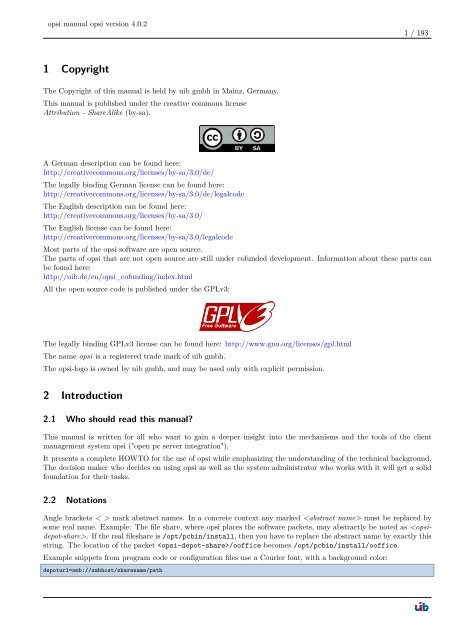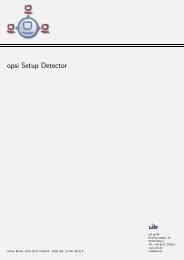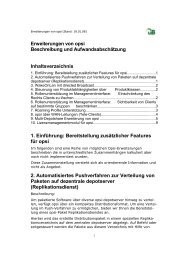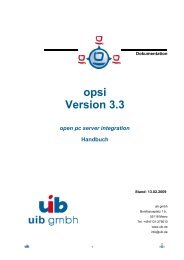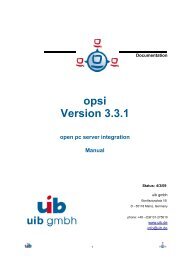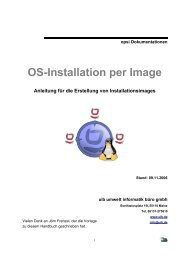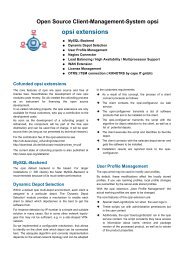opsi manual opsi version 4.0.2 - opsi Download - uib
opsi manual opsi version 4.0.2 - opsi Download - uib
opsi manual opsi version 4.0.2 - opsi Download - uib
Create successful ePaper yourself
Turn your PDF publications into a flip-book with our unique Google optimized e-Paper software.
<strong>opsi</strong> <strong>manual</strong> <strong>opsi</strong> <strong>version</strong> <strong>4.0.2</strong><br />
1 Copyright<br />
The Copyright of this <strong>manual</strong> is held by <strong>uib</strong> gmbh in Mainz, Germany.<br />
This <strong>manual</strong> is published under the creative commons license<br />
Attribution - ShareAlike (by-sa).<br />
A German description can be found here:<br />
http://creativecommons.org/licenses/by-sa/3.0/de/<br />
The legally binding German license can be found here:<br />
http://creativecommons.org/licenses/by-sa/3.0/de/legalcode<br />
The English description can be found here:<br />
http://creativecommons.org/licenses/by-sa/3.0/<br />
The English license can be found here:<br />
http://creativecommons.org/licenses/by-sa/3.0/legalcode<br />
1 / 193<br />
Most parts of the <strong>opsi</strong> software are open source.<br />
The parts of <strong>opsi</strong> that are not open source are still under cofunded development. Information about these parts can<br />
be found here:<br />
http://<strong>uib</strong>.de/en/<strong>opsi</strong>_cofunding/index.html<br />
All the open source code is published under the GPLv3:<br />
The legally binding GPLv3 license can be found here: http://www.gnu.org/licenses/gpl.html<br />
The name <strong>opsi</strong> is a registered trade mark of <strong>uib</strong> gmbh.<br />
The <strong>opsi</strong>-logo is owned by <strong>uib</strong> gmbh, and may be used only with explicit permission.<br />
2 Introduction<br />
2.1 Who should read this <strong>manual</strong>?<br />
This <strong>manual</strong> is written for all who want to gain a deeper insight into the mechanisms and the tools of the client<br />
management system <strong>opsi</strong> ("open pc server integration").<br />
It presents a complete HOWTO for the use of <strong>opsi</strong> while emphasizing the understanding of the technical background.<br />
The decision maker who decides on using <strong>opsi</strong> as well as the system administrator who works with it will get a solid<br />
foundation for their tasks.<br />
2.2 Notations<br />
Angle brackets < > mark abstract names. In a concrete context any marked must be replaced by<br />
some real name. Example: The file share, where <strong>opsi</strong> places the software packets, may abstractly be noted as .<br />
If the real fileshare is /opt/pcbin/install, then you have to replace the abstract name by exactly this<br />
string. The location of the packet /ooffice becomes /opt/pcbin/install/ooffice.<br />
Example snippets from program code or configuration files use a Courier font, with a background color:<br />
depoturl=smb://smbhost/sharename/path


